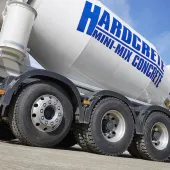CEMEX Vertua concrete used on HS2 project

Pioneering low-carbon concrete used for first time in London to help reduce carbon emissions
AS part of their ambition to build the most sustainable high-speed railway in the world, HS2 contractors in London have begun using Vertua, a new low-carbon concrete product which provides a reduction of 42% in CO2 compared with a standard concrete.
In addition, the remaining carbon emissions from using the concrete are offset to provide a CarbonNeutral product, in accordance with The CarbonNeutral Protocol.
The product, used for the first time in London, has been supplied to HS2’s enabling works contractors Costain Skanska joint venture (CSjv) and Lydon Contracting Ltd by CEMEX, from their plant in Wembley.
After engineering carbon reductions into the concrete mix design, CEMEX calculate the embodied carbon generated from extraction and processing of raw materials, product manufacturing and distribution. The residual carbon is then offset, making the concrete carbon neutral from manufacture to use.
To achieve carbon neutrality, carbon is offset by the removal or reduction of emissions of carbon dioxide or other greenhouse gases from the atmosphere in order to compensate for emissions made elsewhere.
CEMEX facilitate this by investing in projects which physically remove CO2 where possible from the atmosphere, such as planting more trees or protecting against deforestation through an independently audited and verified project. This is done in accordance with international standards for carbon neutrality.
The first use of Vertua Classic Zero concrete in the capital recently took place at an HS2 site in north-west London, ready to prepare the ground for an electricity substation which will power the tunnel-boring machines excavating HS2’s London tunnels. A further delivery of Vertua is planned at the same site by the end of October.
By using this low-carbon concrete, a total of 12 tonnes of carbon should be saved once deliveries are complete, with an additional 17 tonnes of residual CO2 offset. Discussions are also continuing as to how this technology can be adopted on further sites across the HS2 route.
HS2 Ltd aim to build the most sustainable high-speed railway in the world and are driving innovation in design, construction and operation to minimize their entire carbon footprint.
In order to become the UK’s most environmentally responsible infrastructure project, HS2 have set a carbon-reduction target of 50% for their contractors on construction baselines for Phase One civil assets (such as tunnels, viaducts and cuttings), stations and railway systems.
Peter Miller, environment director at HS2 Ltd, said: ‘We know that climate change is the greatest long-term threat to Britain’s security and prosperity. The Government has set a target for net-zero emissions by 2050 and HS2 are playing their part in meeting that challenge.
‘Using innovative techniques and products in the construction of the new high-speed railway, we can not only build HS2 more sustainably, but we can lead by example, showing how the construction sector can help deliver Britain’s cleaner greener future.’
Dan Hunt, programme director at Costain Skanska joint venture, said: ‘Working closely with our supply chain, we have identified many ways to maximize our environmental credentials, leading to more than 3,000 tonnes of carbon dioxide equivalent (CO2e) saved to date.
‘We have focused on identifying innovations and efficiencies throughout our whole programme, from our power supplies and fuel sources through to working methodology by reducing and recycling materials.
‘We have worked hard to reduce the amount of concrete needed across the programme, and by working with CEMEX, we have further reduced the carbon footprint of our works.’
Richard Kershaw, technical manager for materials at CEMEX UK, said: ‘We are proud to have supplied this HS2 site with our Vertua concrete, the first time this low-carbon product has been used in our country’s capital.
‘We know that minimizing the carbon footprint for the HS2 project is of real importance, and our Vertua concrete offers an easy way to make a more sustainable choice for such an important product. We look forward to exploring the other opportunities for Vertua to be used as part of HS2.’









